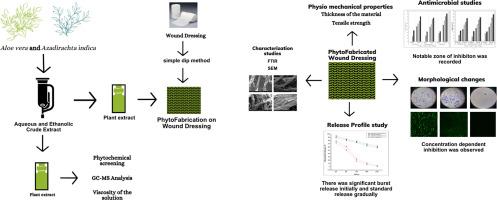Antimicrobial activity of herbal biomass derived metabolites fabricated wound dressing material against microbial strains causing skin infection
IF 2.7
3区 生物学
Q2 PLANT SCIENCES
引用次数: 0
Abstract
In the present study, anti-microbial activity of wound dressing material coated with Aloe vera and Azadirachta indica metabolites was investigated on pathogenic microbial strains associated with skin infection. Anti-microbial active metabolites extracted from the respective medicinal plant were fabricated on the wound dressing material by simple, in situ green science principles. Confirmation of phytochemicals fabrication on the fibre surface of the material was studied by Fourier-transform infrared spectroscopy (FTIR) and scanning electron microscopy (SEM) Additionally, the impact of phyto-constituents fabrication on mechanical properties such as thickness and tensile strength was assessed. The anti-microbial efficacy of the fabricated dressing against pathogenic microorganisms (Candida albicans, Escherichia coli ATCC 25922, and Staphylococcus aureus ATCC 25923) was evaluated using agar diffusion assay. The release profile of phytochemical constituents from the fabricated wound dressing was investigated using ethanol and distilled water as solvents. The results showed that the phytochemical constituents were fabricated effectively on the wound dressing material and exhibiting notable growth inhibition potential against tested pathogenic strains. The release profile study revealed an initial burst release of phytochemical constituents followed by a controlled or sustained pattern. In conclusion, wound dressings infused with plant extracts present a promising approach for wound care applications and show potential for various healing-related purpose.

草药生物质衍生代谢物制成的伤口敷料对引起皮肤感染的微生物菌株的抗菌活性
本研究调查了涂有芦荟和杜鹃花代谢物的伤口敷料对皮肤感染相关病原微生物菌株的抗微生物活性。通过简单的原位绿色科学原理,在伤口敷料上制造了从相应药用植物中提取的抗微生物活性代谢物。傅立叶变换红外光谱(FTIR)和扫描电子显微镜(SEM)证实了植物化学物质在材料纤维表面的形成。 此外,还评估了植物成分的形成对厚度和拉伸强度等机械性能的影响。使用琼脂扩散试验评估了制成敷料对病原微生物(白色念珠菌、大肠杆菌 ATCC 25922 和金黄色葡萄球菌 ATCC 25923)的抗微生物功效。以乙醇和蒸馏水为溶剂,研究了植物化学成分从制成的伤口敷料中的释放情况。结果表明,植物化学成分能有效地在伤口敷料材料上形成,并对测试的致病菌株表现出显著的生长抑制潜力。释放曲线研究表明,植物化学成分最初会突然释放,随后会出现受控或持续的释放模式。总之,注入植物提取物的伤口敷料为伤口护理应用提供了一种前景广阔的方法,并在各种与愈合相关的用途上显示出潜力。
本文章由计算机程序翻译,如有差异,请以英文原文为准。
求助全文
约1分钟内获得全文
求助全文
来源期刊

South African Journal of Botany
生物-植物科学
CiteScore
5.20
自引率
9.70%
发文量
709
审稿时长
61 days
期刊介绍:
The South African Journal of Botany publishes original papers that deal with the classification, biodiversity, morphology, physiology, molecular biology, ecology, biotechnology, ethnobotany and other botanically related aspects of species that are of importance to southern Africa. Manuscripts dealing with significant new findings on other species of the world and general botanical principles will also be considered and are encouraged.
 求助内容:
求助内容: 应助结果提醒方式:
应助结果提醒方式:


